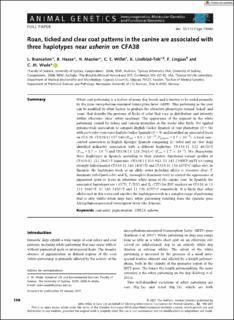| dc.description.abstract | White coat patterning is a feature of many dog breeds and is known to be coded primarily by the gene micropthalmia-associated transcription factor (MITF). This patterning in the coat can be modified by other factors to produce the attractive phenotypes termed ‘ticked’ and ‘roan’ that describe the presence of flecks of color that vary in distribution and intensity within otherwise ‘clear’ white markings. The appearance of the pigment in the white patterning caused by ticking and roaning intensifies in the weeks after birth. We applied genome-wide association to compare English Cocker Spaniels of roan phenotype (N = 34) with parti-color (non-roan) English Cocker Spaniels (N = 9) and identified an associated locus on CFA 38, CFA38:11 057 040 (Praw = 8.9 × 10−10, Pgenome = 2.7 × 10−5). A local case–control association in English Springer Spaniels comparing 11 ticked and six clear dogs identified indicative association with a different haplotype, CFA38:11 122 467G>T (Praw = 1.7 × 10−5) and CFA38:11 124 294A>C (Praw = 1.7 × 10−5). We characterize three haplotypes in Spaniels according to their putative functional variant profiles at CFA38:11 111 286C>T (missense), CFA38:11 131 841–11 143 239DUP.insTTAA (using strongly linked marker CFA38:11 143 243C>T) and CFA38:11 156 425T>C (splice site). In Spaniels, the haplotypes work as an allelic series including alleles (t, recessive clear; T, dominant ticked/parti-color; and TR, incomplete dominant roan) to control the appearance of pigmented spots or flecks in otherwise white areas of the canine coat. In Spaniels the associated haplotypes are t (CCT), T (TCC) and TR (TTT) for SNP markers on CFA38 at 11 111 286C>T, 11 143 243C>T and 11 156 425T>C respectively. It is likely that other alleles exist in this series and together the haplotypes result in a complex range of patterning that is only visible when dogs have white patterning resulting from the epistatic gene Micropthalmia-associated transcription factor (the S-locus). | |
